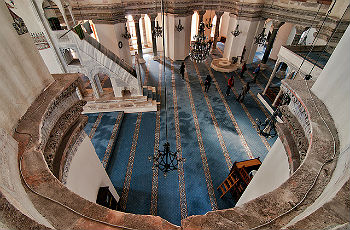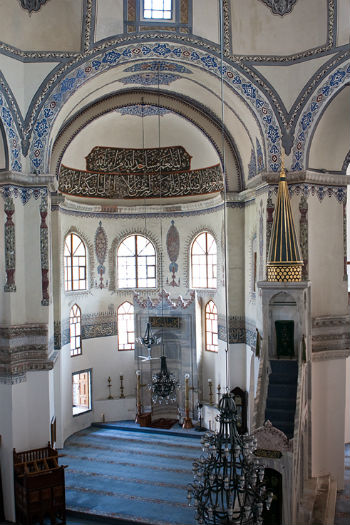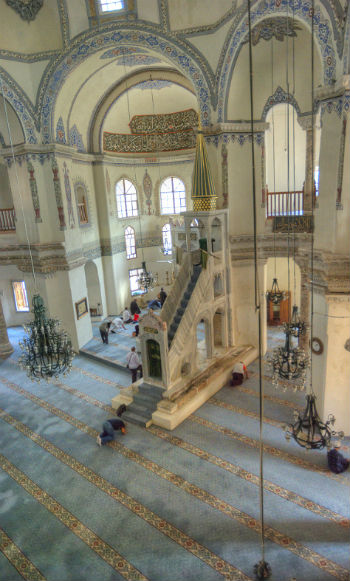Begun in 527 by Emperor Justinian, the Church of Saints Sergius and Bacchus in Istanbul was an early experiment in Byzantine architecture, with a large central dome supported by an octagonal base. The church is now a mosque called Küçük Ayasofya Camii (Little Hagia Sophia Mosque), named for its resemblance to the much larger Hagia Sophia built a few years later.
History
Saints Sergius and Bacchus are Christian Roman soldiers who were martyred in Syria in 303 AD. They became the patron saints of soldiers and their cult was very popular in Syria and beyond.
The Byzantine Emperor Justinian (r. 527-65) was among the saints’ devotees. According to legend, when Justinian was a young man he was condemned to death for plotting against Emperor Anastasius. But Sergius and Bacchus appeared to the emperor in a dream, convincing him to release Justinian.
Justinian began construction on a church dedicated to Sts Sergius and Bacchus immediately after becoming emperor himself in 527 AD; it was completed by 536 AD. The architect was Anthemius of Tralles, a mathematician and the author of a book on burning mirrors, the Paradoxographia. The chosen site was just inside the sea walls west of the Hormisdas Palace (where Justinian lived before ascending the throne), next to the Hippodrome.
The church was connected to a three-aisled basilica dedicated to St. Peter and St. Paul, which Justinian had begun to build in 519. None of it survives today. The Church of Sts. Sergius and Bacchus was built on an octagonal floor plan with a central dome, which inspired the design of the great Hagia Sophia, begun just a few years later in 532. The earlier church was therefore dubbed the Little Ayasofya.
The church was converted into a mosque in the 16th century under Sultan Beyazit II and remains an active mosque today.
What to See
Church of the Saints Sergius and Bacchus is located on the south side of Istanbul next to the Hippodrome; a railway line (near Sirkeci Station) runs between the south wall of the church and sea wall.
The Church of the Saints Sergius and Bacchus interior is decorated and furnished as a mosque, with Arabic calligraphy and designs in blue painted on white walls. Originally, the walls and vault would have been completely covered in golden mosaics, like those that survive from this period in Ravenna, and probably frescoes as well.
The architecture of the building, however, survives fully intact from the Byzantine era. So too does the Greek dedicatory inscription around the central nave:
A fine view of the interior can be had from the gallery stairs are to the right of the entrance.











It is beautiful inside and you can go onto the balcony up some steps that are know carpet covered but you need to be careful.
While visiting Topkapi Palace a Turkish man told me about the Little Hagia Sophia which is located near the Blue Mosque. It is a smaller version of the magnificent Hagia Sophia but is used as a mosque.
We came upon this converted mosque by chance as it was close to our hotel. We couldn't be bothered with the queues and crowds of the big brother version but here was cool, calm and relaxed. We borrowed a headscarf and wandered around going upstairs and on the balcony too.
While not comparable to the real Hagia Sophia, the architecture and some of the decorations are still worth a visit. It's a short walk from the hustle and bustle of Sultanahmet, and next to the old city walls of Istanbul.
"Little Ayasofya" is beautiful on the inside and you can go upstairs as well, which is unusual. Be careful coming down the stairs! They are well worn and carpeted, so socks will be slippery. There is an interesting cemetery on the grounds as well as a courtyard filled with artists' studios.
The opportunity to see so many of the founding churches of Christianity and their incarnations as mosques after the Ottoman conquest–fascinating.
We decided to visit the "Little Hagia Sophia" (so called because it was also built by Justinian, along similar lines to the Hagia Sophia) before visiting some of the larger and more famous buildings. It is certainly less spectacular than the Hagia Sophia, but it has something to offer for people who are interested in older buildings.
Exquisite interior, one of the gems of Istanbul, but often overlooked because of its proximity to other, grander mosques. Worth making time to visit. It's lovely.